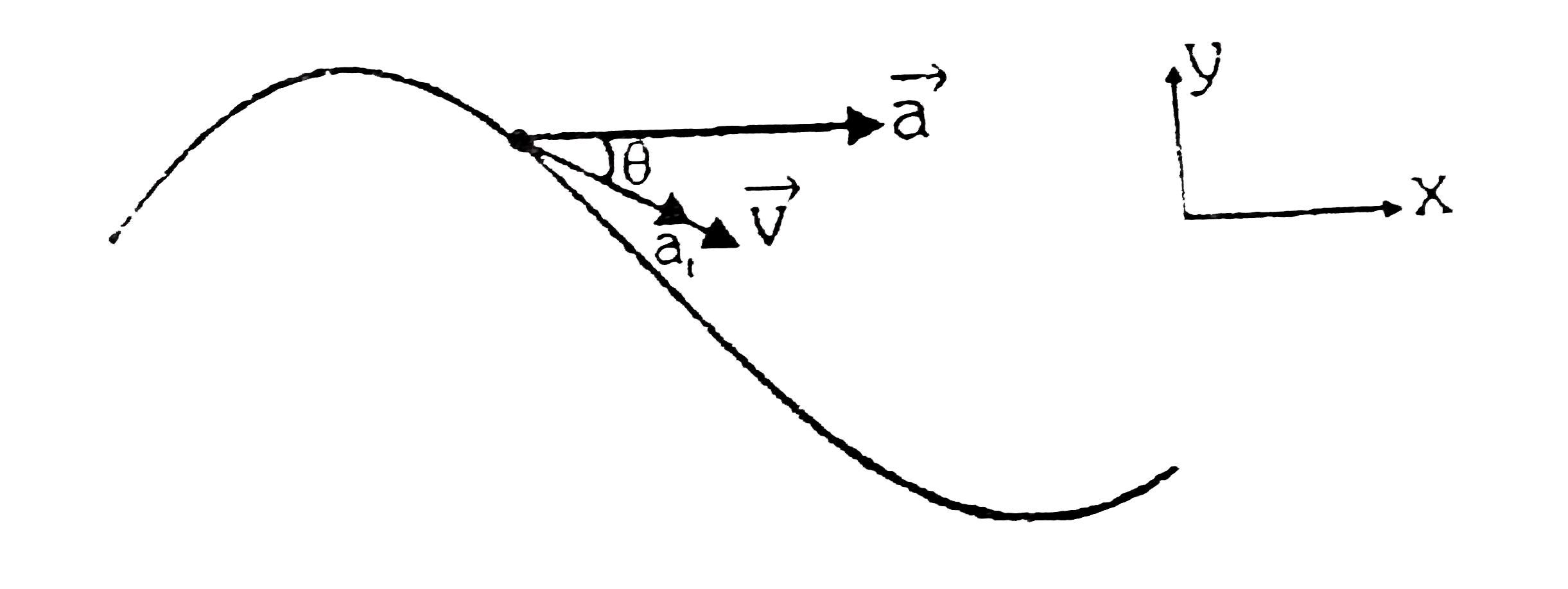A particle moves with a tangential acceleration at=→a.ˆv where →a=(5ˆi)m/s2. If the speed of the particle is zero at x=0, then find v (in m/s) at x=4.9m.
 Solution in Gujrati
Solution in Gujrati
The correct Answer is:7
As dvd=→a.→dr=adx=5dx⇒∫v0vdv=5∫4.90dx⇒v22=5(4.9)⇒v2=49⇒v=7m/s
Topper's Solved these Questions
- KINEMATICSBOOK - ALLEN CHAPTER - KINEMATICSEXERCISE - EXERCISE-01
55 Videos
- KINEMATICSBOOK - ALLEN CHAPTER - KINEMATICSEXERCISE - EXERCISE-02
57 Videos
- ERROR AND MEASUREMENTBOOK - ALLEN CHAPTER - ERROR AND MEASUREMENTEXERCISE - Part-2(Exercise-2)(B)
22 Videos
- KINEMATICS (MOTION ALONG A STRAIGHT LINE AND MOTION IN A PLANE)BOOK - ALLEN CHAPTER - KINEMATICS (MOTION ALONG A STRAIGHT LINE AND MOTION IN A PLANE)EXERCISE - BEGINNER S BOX-7
8 Videos
Similar Questions
A bird moves from point (1,−2,3) to (4,2,3). If the speed of the bird id 10m/s, then the velocity of the bird is :-
View SolutionA particle is moving in a plane with velocity given by →u=u0ˆi+(aωcosωt)ˆj, where ˆi and ˆj are unit vectors along x and y axes respectively. If particle is at the origin at t=0. Calculate the trajectory of the particle :-
View SolutionA cube has a side of length 1.2×10−2m. Calculate its volume.
View SolutionA football player kicks a ball at an angle of 30∘ with an initial speed of 20 m/s. Assuming that the ball travels in a vertical plane, calculate (a) the time at which the ball reaches the highest point (b) the maximum height reached (c) the horizontal range of the ball (d) the time for which the ball is in the air, (g=10m/s2)
View SolutionThe speed of a particle moving in a circle of radius r=2m varies with time t as v=t2, where t is in second and v in m/s. Find the radial, tangential and net acceleration at t=2s.
View SolutionA particle is moving with a constant acceleration vec(a) = hat(i) - 2 hat(j) m//s^(2) and instantaneous velocity vec(v) = hat(i) + 2 hat(j) + 2 hat(k) m//s then rate of change of speed of particle 1 second after this instant will be :
View SolutionA particle is moving with a velocity of vec(v)=(3hat(i)+4that(j))m//s . Find the ratio of rangential acceleration to that of total acceleration at t=1sec
View SolutionA particle leaves the origin with initial velocity →v0=11ˆi+14ˆjm/s. It undergoes a constant acceleration given by →a=−225ˆi+215ˆjm/s2.
When does the particle cross the y-axis ?
View SolutionIf a vector →v is such that 2→v+→v×[ˆi+2ˆj]=2ˆi+ˆkand|→v|=13√m, then m is equal to -
View SolutionAcceleration of a particle is given by
a=1/V
Where V is the velocity . Find
(i) Velocity of particle at time t, given that v = 10 m/s at t = 0.
(ii) Velocity of particle when its position is x, given that speed is 3 m/s at x = 0.
View Solutionदो कण जिनके स्थिति सदिश →r1=(3ˆi+5ˆj)m तथा→r2=(−5ˆi−3ˆj)m है क्रमशः →V1=(aˆi+4ˆj)m/s तथा →V2=(4ˆi)m/s चाल से गतिमान है। यदि ये 2 सेकंड पश्चात टकराते हो , तो a का मान है
View SolutionA force →F=(ˆi−ˆj)N acts on a particle which moves with a velocity →V=(−2ˆi−3ˆk)m/s. Find the power delivered by the force. Usie the formula P=→F.→v
View SolutionForce vec(F ) = (60 hat(i) +50 hat(j)-3hat(k))N is applied on a particle , the value of velocity is vec(v) =(2hat(i)+4hat(j)+5hat(k)) m/s , then power will be ……. W.
View SolutionThe speed of a particle moving in a circle of radius r=2m varies with time t as v=t2, where t is in second and v in m/s. Find the radial, tangential and net acceleration at t=2s.
View SolutionThe speed of a particle moving in a circle of radius r=2m varies witht time t as v=t^(2) , where t is in second and v in m//s . Find the radial, tangential and net acceleration at t=2s .
View SolutionVelocity of a particle moving in a curvilinear path in horizontal XY plane varies with time as →v=(2tˆi+t2→jm / s. Here, t is in second. At t =1s, the radius of curve ture of the path is α√5βm. Find (α+β).
View Solution
